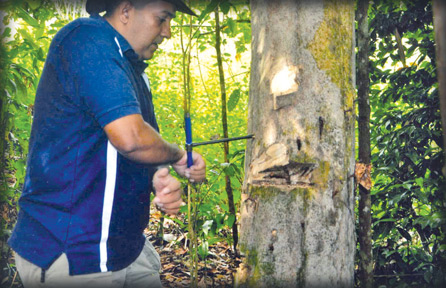Walla patta, a money-spinner
by K.K.D. Premalal- Matugama Spl. Cor.
People find many ways to earn money. Be they legal or illegal, they
try to accomplish their task. Rumours spread that there is a very good
demand for old coins, valampuri (left-turned conch shells), some insect
species like geckos and scorpions. The demand for walla patta is also on
the rise. Cutting down walla patta trees has become a lucrative
business. Once the tree was considered unimportant and all of a sudden
it has become very commercialised in recent years.
Walla patta is a tree that grows up to 15 metres. The botanical name
of the tree is Gyrinops walla. It has a straight slender trunk which has
a thin brownish grey smooth and strong fibrous bark. Gyrinops walla, a
member of the family Thymalaeceae is found in the wet zone of Sri Lanka
and very rarely in South West India. Agarwood is a resin produced by
certain species of Thymalaeceae due to a self - defence mechanism.
|

Dr. Upul Subasinghe making an incision to check whether the
tree contains resin |
Agarwood, a highly valuable and fragrant resin is used as incense for
religious ceremonies, perfumes in the Arab world, aroma therapy,
ornamental materials and medicinal components in oriental medicine.
The Sunday Observer spoke to Dr. Upul Subasinghe, a senior lecturer
in Forest and forest plantation management and natural Resource
Modelling in the Department of forestry and Environmental Science, the
University of Jayewardenepura. He said people should realise that all
walla patta trees do not contain agarwood. It is formed due to defence
mechanism to stop intruders entering the stem.
Dr. Subasinghe started researching on this species with his
colleagues in 2010 and compared the compounds with other commercially
available agarwood.
large scale
He also said large scale smuggling of walla patta from Sri Lanka has
been practised for a long time.In the context of preservation G walla
has been protected under the Flora and Fauna Protection Ordinance (FFPO)
in Sri Lanka since 2004 and convention on International Trade in
Endangered Species (CITES) since 2005.
A Range Forest Officer in Matugama - Agalawatta area who preferred to
remain anonymous said, "people have given up their usual jobs and
started going into forests to cut down walla patta trees.
We get many tip offs about people who enter forests to cut down walla
patta. We are always ready to apprehend the culprits.
No facilities
He was not happy with the facilities they are provided with.
He said that they lack vehicles to move here and there. "When we hire
vehicle and reach the destination, they can go to a safer place."
 He said every tree in the forest is important. Some people say that
walla patta trees are useless. If they are useless, why do they cut them
down?When we go into the forest, we face untold hardships and sometimes
our lives are at a risk. He also said protecting the forest is his
bounding duty. He said every tree in the forest is important. Some people say that
walla patta trees are useless. If they are useless, why do they cut them
down?When we go into the forest, we face untold hardships and sometimes
our lives are at a risk. He also said protecting the forest is his
bounding duty.
He said they get the assistance of the police when necessary. He also
suggested to sell walla patta saplings to the needy people. For this,
government authorities should take necessary steps to start nurseries.
The private sector has already started selling walla patta saplings.
Binding material
K.K. Premaratne, a villager in Pareigama area said, our fathers and
forefathers did not consider this tree as a valuable tree.
They did not want to keep them in their home gardens. The trees were
in the forest in abundance. We use the bark as a binding material.
The wood is very light and we made handles of knives and billhooks
using the wood. We used it as a rope for binding kitul flowers to obtain
sap to make kitul juggery and toddy. I can still remember how my
grandmother crushed some tender leaves of walla patta and put on the
decayed tooth.
Those days there were no dentists. That is how our grand parents
extracted our teeth. We also used the tree trunk to put up the structure
of wattle and daub houses.
However, he was not happy with the destruction caused to the forest
by cutting down walla patta trees. People who enter the forest do some
illegal activities. He said heavy fines should be imposed on them.
Due to the proven high Agarwood resinous value of the Walla patta (Gyrinops
walla) trees, Dr. Upul Subasinghe who is a committee member of
popularising Walla patta tree cultivation among villagers and other
relevant bodies, suggested the name "Sri Lankan Agar" for this species
in order to make a Brand Name in the international market.
The Ministry accepted the name based on the reasons provided by Dr.
Subasinghe and decided to use the name Sri Lankan Agar from now on.
Research
According to the results over three year research, Dr. Subasinghe
believes the quality of Sri Lankan Agar matches with the other Agarwood
products coming to the international market from the South Asian
countries. Therefore the Agarwood production of Walla patta, if properly
developed, can be used to earn a significant foreign income contributing
to the poverty alleviation of the rural community in the low country wet
zone. The government should take every step to preserve this tree and we
can fill the state coffers by exporting the resin of the tree to the
foreign market.
|

